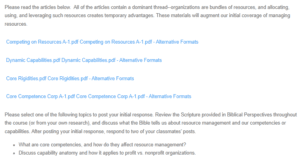Core Competencies and Resource Management
According to Prahalad & Hamel (1997), core competencies stem from a firm’s ability to develop a product at a lower cost and a faster rate than its competitors. They view this phenomenon as an inherent trait of the firm and one that can be identified by three features. First, the core competency should be difficult to imitate, such that rival firms cannot replicate the product, service, or process. Secondly, it should provide additional value to customers as compared to other products in the market. Lastly, it should enhance the firm’s accessibility to the market. On the other hand, Leonard‐Barton (1992) identifies core competencies from a knowledge-based perspective that includes employees’ knowledge, technical skills, managerial structure and values, and norms. The author further argues that these domains can either enhance or downgrade a company’s niche in the industry, depending on how they are employed. Eisenhardt & Martin (2000) illustrate that dynamic capabilities are composed of what is commonly referred to as best practice. This concept in itself does not signify a core competency, but rather, the allocation of resources to these dynamics determines their competitive advantage. Collis & Montgomery (1995) argue that resource management lies in continually investing in the corporation’s resources to gain a competitive advantage in the industry. Resources are identified by the following features: imitability, durability, substitutability, appropriability, and competitive superiority.
Proverbs 27:23 ‘Be diligent to know the state of your flocks, and attend to your herds.’ This analogy is used to depict customer satisfaction by effectively meeting their needs. Companies should use their resources to precisely identify their customers’ needs, wants, and preferences. Subsequently, these firms should produce products and services that match the mentioned traits. Resource management involves tailoring resources to enhance customer satisfaction.
In conclusion, core competencies and resources management are inter-twined concepts that should be employed by companies in gaining a niche in the industry.
References
Prahalad, C. K., & Hamel, G. (1997). The core competence of the corporation. In Strategische Unternehmungsplanung/Strategische Unternehmungsführung (pp. 969-987). Physica, Heidelberg.
Collis, D. J., & Montgomery, C. A. (1995). Competing on Resources: Strategy in the 1990s. Knowledge and strategy, 25-40.
Leonard‐Barton, D. (1992). Core capabilities and core rigidities: A paradox in managing new product development. Strategic Management Journal, 13(S1), 111-125.
Eisenhardt, K. M., & Martin, J. A. (2000). Dynamic capabilities: what are they? Strategic Management Journal, 21(10‐11), 1105-1121.
Version, K. J. (2017). Holy Bible. Arcturus Publishing Limited.
ORDER A PLAGIARISM-FREE PAPER HERE
We’ll write everything from scratch
Question

Core Competencies and Resource Management
Please read the articles below. All of the articles contain a dominant thread–organizations are bundles of resources, and allocating, using, and leveraging such resources creates temporary advantages. These materials will augment our initial coverage of managing resources.
Competing on Resources A-1.pdf Competing on Resources A-1.pdf – Alternative Formats
Dynamic Capabilities.pdf Dynamic Capabilities.pdf – Alternative Formats
Core Rigidities.pdf Core Rigidities.pdf – Alternative Formats
Core Competence Corp A-1.pdf Core Competence Corp A-1.pdf – Alternative Formats
Please select one of the following topics to post your initial response. Review the Scripture provided in Biblical Perspectives throughout the course (or from your own research), and discuss what the Bible tells us about resource management and our competencies or capabilities. After posting your initial response, respond to two of your classmates’ posts.
- What are core competencies, and how do they affect resource management?
- Discuss capability anatomy and how it applies to profit vs. nonprofit organizations.

